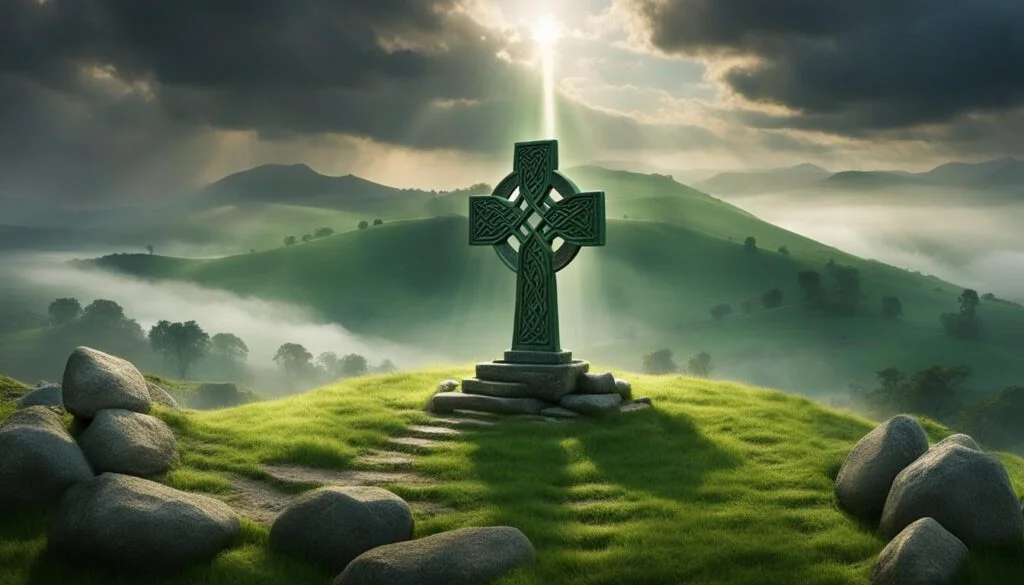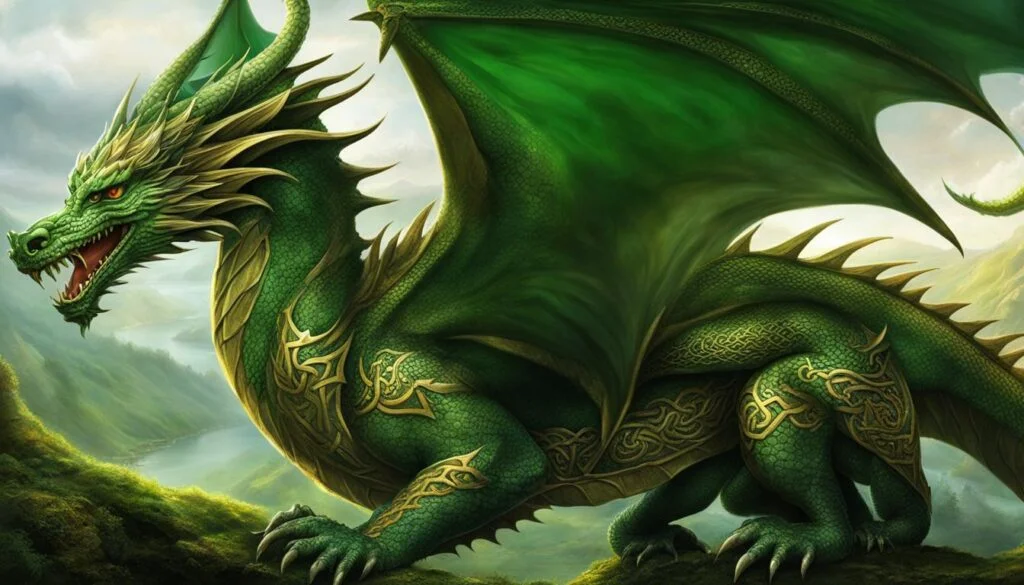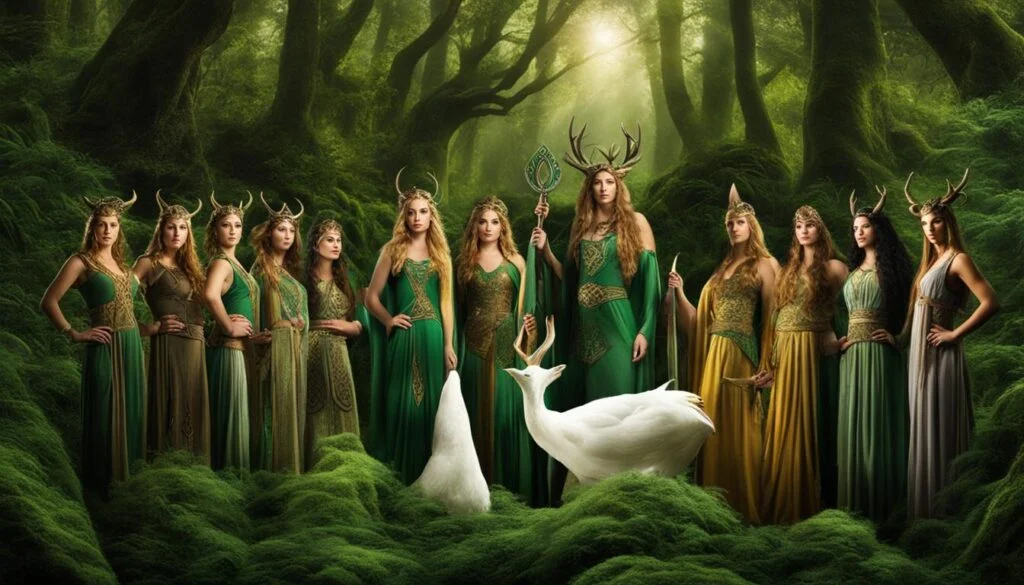The Celtic Cross is a fascinating emblem that holds a significant place in history and carries profound symbolism. It has captured the imagination of many with its intricate design and cultural significance. In this article, we will delve into the history and symbolism of the Celtic Cross, exploring its origins, meanings, and interpretations.
Key Takeaways:
- The Celtic Cross has a rich history and is believed to have originated in pagan times before the arrival of Christianity to Ireland.
- The circle in the cross represents continuity, eternity, and the spiritual realm.
- The Celtic Cross serves various functions, including religious instruction, marking boundaries, and providing sanctuary.
- Today, the Celtic Cross is widely worn as jewelry to express faith and Irish heritage.
- Its symbolism and design have evolved over time, making it a distinctive symbol in Irish culture.
Origins of the Celtic Cross
The exact origin of the Celtic Cross is unknown, but it is believed to have emerged in the Middle Ages. There are different theories about its advent, with one suggesting that St. Patrick merged Christian and pagan symbols to convert the Irish population. Another theory proposes that it evolved from pagan worship of the sun god and the four-spoked wheel.
The Celtic Cross has been a symbol of Irish culture and faith for over 1500 years and has spread to other Celtic cultures in Wales, Scotland, and England.
One theory about the origins of the Celtic Cross suggests that St. Patrick, the patron saint of Ireland, played a significant role in its creation. During his missionary work in Ireland, he is said to have merged Christian and pagan symbols to help convert the Irish people to Christianity. By combining the traditional cruciform shape with a circle, he may have incorporated pagan beliefs of the sun god. This fusion of symbols allowed for a smooth transition from paganism to Christianity and gave birth to the distinctive Celtic Cross design.
Another theory proposes that the Celtic Cross originated from the pagan worship of the sun god and the four-spoked wheel. The sun symbol was a significant element in pagan rituals, representing life, warmth, and fertility. The four-spoked wheel, also known as the solar wheel or sun wheel, symbolized the cycles of nature and the changing seasons. Over time, the combination of these pagan symbols with the Christian cross resulted in the creation of the Celtic Cross.
Regardless of its exact origin, the Celtic Cross has become deeply ingrained in Irish culture and spirituality. It is revered as a symbol of faith and heritage, carrying with it centuries of history and cultural significance.
Spread and Cultural Significance
The Celtic Cross not only became an iconic symbol in Ireland but also spread to other Celtic cultures, including Wales, Scotland, and England. It represents a shared heritage and cultural identity among these Celtic nations. The cross served as a visual representation of faith, marking the arrival of Christianity in these regions.
Over time, the Celtic Cross evolved to incorporate regional variations and artistic interpretations. The design became more intricate and complex, often featuring elaborate carvings, Celtic knots, and interlacing patterns. These variations reflect the diverse artistic styles and cultural influences within the Celtic regions, further enriching the symbolism and meaning of the Celtic Cross.
Symbolism of the Celtic Cross
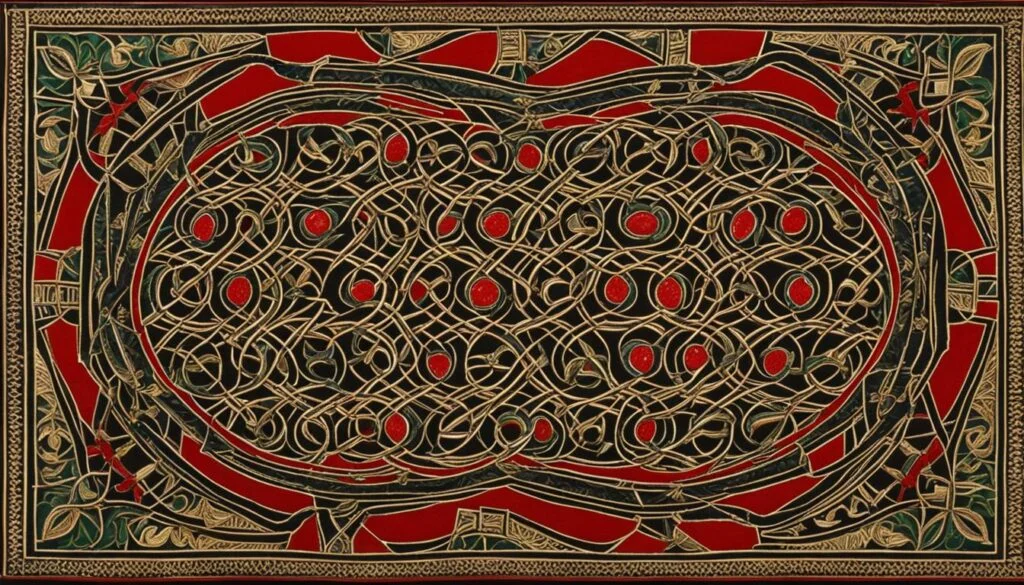
The Celtic Cross is imbued with rich symbolism and deep meaning. At the heart of the cross lies a circle, which represents continuity, eternity, and the spiritual realm. This circle is also associated with the Celtic Shield, symbolizing support and strength that surrounds the cross.
The four arms of the Celtic Cross hold significant significance as well. They can represent the four cardinal directions, symbolizing the connectivity between the physical and spiritual worlds. Alternatively, they can embody the four elements: earth, air, fire, and water, which hold symbolic importance in many spiritual traditions.
As the Celtic Cross evolved over time, later iterations featured intricate designs and panels, often depicting biblical scenes. These artistic adornments served as a means of religious instruction, particularly for those who were illiterate. The decorative panels were vibrant and colorful, capturing the attention of viewers and effectively conveying the teachings of the Christian faith.
Other Functions of the Celtic Cross
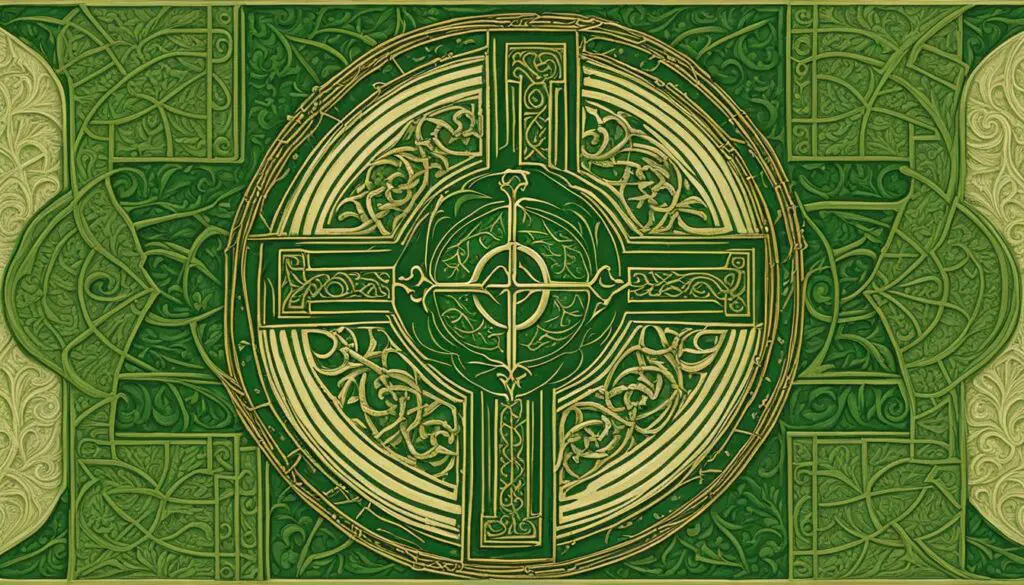
Aside from its primary role in religious instruction, the Celtic Cross served various other functions throughout history. One notable function was its use as a boundary marker outside monastic settlements, known as Termon crosses. These crosses played a vital role in providing sanctuary to those seeking refuge. Fugitives could claim protection within the boundaries of the monastic enclosure, under the care of the monks.
Furthermore, some Celtic crosses held additional historical significance. A prime example is the Market Cross in Kells, which was utilized for more somber purposes during the 1798 rebellion. The cross became a grim site for hanging captured rebels, serving as a haunting reminder of Ireland’s turbulent past.
Termon Crosses: A Place of Sanctuary
- The Celtic Cross served as a boundary marker for monastic settlements.
- Termon crosses granted sanctuary to fugitives seeking refuge.
- The monastic enclosure provided a safe haven under the care of the monks.
The Market Cross in Kells
- The Market Cross in Kells held historical significance.
- This cross was associated with grim events during the 1798 rebellion.
- It served as a site for the hanging of captured rebels.
Celtic Cross Design and Variations
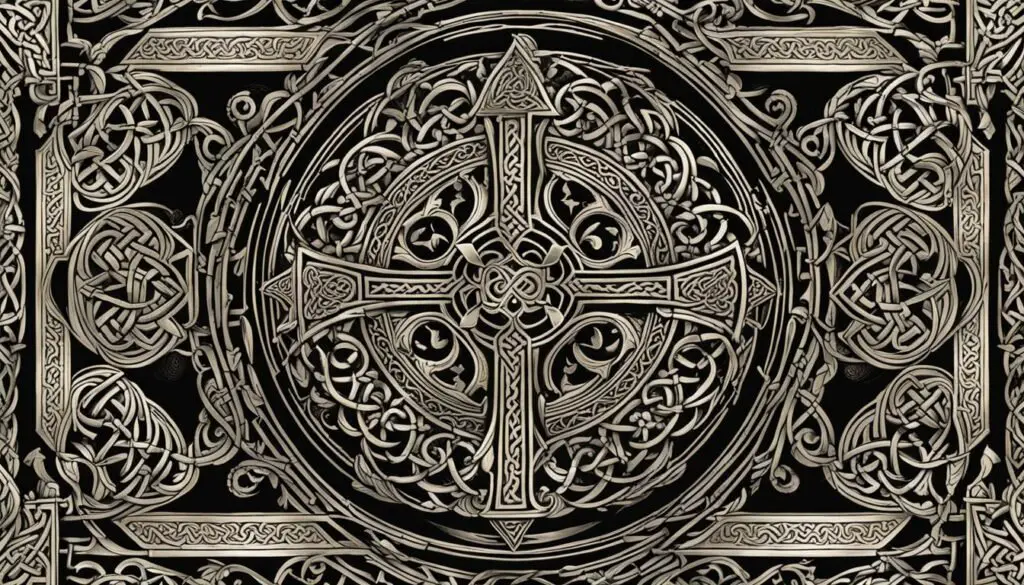
The design of the Celtic Cross has evolved over time, resulting in various captivating variations. In earlier versions, the cross’s arms were contained within the circle, while newer designs feature longer arms that extend beyond the circle, creating a more elaborate and eye-catching structure.
The panels on the Celtic Cross have also undergone transformation throughout history. Initially, these panels were inscribed with nature-inspired motifs or geometric symbols, reflecting the Celtic culture’s close connection with the natural world. However, as time passed, these panels evolved to depict intricate biblical scenes, reinforcing the cross’s religious significance.
Modern Celtic crosses exhibit a fusion of historical tradition and contemporary artistic influences. They often incorporate geometric panel designs, spirals, and key patterns inspired by the exquisite metalwork of the Celts. These elements contribute to the cross’s distinct aesthetic appeal, making it a cherished symbol within Celtic communities.
There are two main types of Celtic crosses widely recognized today. The first is the Celtic Memorial Cross, which is commonly used as a poignant symbol on gravestones and serves as a lasting tribute to the departed. The second type is the Celtic High Cross, which is primarily used for ornamental purposes within churches, adding an element of elegance and spirituality to sacred spaces.
Origins of the Celtic Cross – The Druids

The origins of the Celtic Cross have been the subject of much speculation and debate. One theory suggests that St. Patrick, the patron saint of Ireland, incorporated common Druid and Pagan symbols into the creation of the Celtic Cross. The Druids, ancient priests in Celtic culture, worshiped circular stones as symbols of eternity. St. Patrick is believed to have added a Christian cross on top of these stones, infusing them with the blessings of Christianity.
Another theory proposes that the Celtic Cross emerged from the pagan culture itself, and St. Patrick strategically combined Pagan symbols with the Christian cross to facilitate the conversion of the Pagan population to Christianity. By incorporating familiar elements from their existing belief system, St. Patrick made the transition to Christianity more accessible and relatable for the people.
The exact origin of the Celtic Cross may remain elusive, but its fusion of ancient symbols and the Christian cross carries deep significance and reflects the cultural and religious blend that Ireland experienced during its historical journey.
Pagan Roots of the Celtic Cross

While the exact origins of the Celtic Cross are debated, some believe that it has Pagan roots. This theory suggests that the cross incorporates Pagan sun symbols and incorporates Celtic Trinity Knot designs in jewelry. Although the relationship between St. Patrick and the existing Pagan symbolism is not fully understood, it is clear that the Celtic Cross became a popular motif in both Pagan and Christian cultures.
To explore the Pagan origin of the Celtic Cross, we can look at the use of sun symbols in ancient Pagan cultures. The circle in the Celtic Cross is thought to represent the sun deity, which was an important focus of Pagan worship. By combining the Christian cross with Pagan sun symbols, St. Patrick may have aimed to ease the transition to Christianity for the Pagan population.
An intriguing aspect of the Celtic Cross is the incorporation of Celtic Trinity Knot designs, which have deep symbolic meaning in Pagan cultures. The Trinity Knot represents the interconnectedness of three elements, often associated with the Earth, Sea, and Sky. By intertwining the Trinity Knot with the Christian cross, the Celtic Cross may have served as a bridge between Pagan and Christian belief systems.
While the Pagan origin of the Celtic Cross is subject to debate, its enduring popularity and significance in both Pagan and Christian cultures cannot be denied. The cross remains an iconic symbol of faith, heritage, and cultural identity, captivating people across generations.
Related Articles:
- Celtic Cross History and Symbolism Explained
- Origins of the Celtic Cross
- Symbolism of the Celtic Cross
The Celtic Cross Today
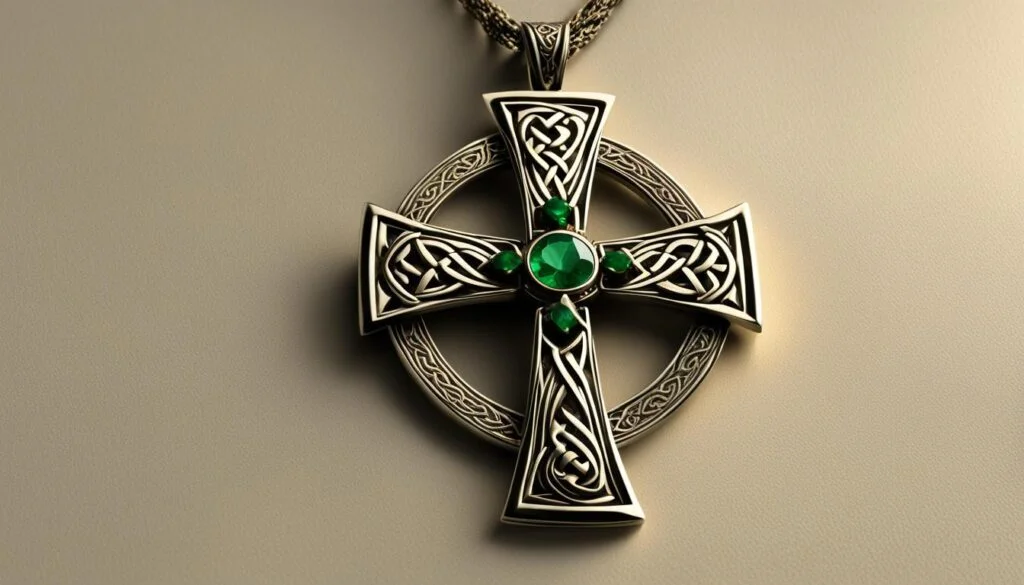
The Celtic Cross has stood the test of time, remaining a beloved symbol in modern times. Its iconic design is widely incorporated into various forms of jewelry, including necklaces, bracelets, and pendants.
By adorning oneself with Celtic Cross jewelry, individuals can proudly showcase their faith and Irish heritage. This timeless symbol serves as a powerful expression of devotion, spirituality, and cultural pride.
Moreover, the Celtic Cross is not limited to jewelry alone. Its distinct design can be found on different types of apparel, ranging from tribal-inspired outfits to vibrant tattoos. This artistic integration of the Celtic Cross further strengthens its significance as a representation of personal identity and connectivity to the past.
During the Celtic revival in the 19th century, the Celtic Cross assumed additional roles beyond its religious connotations. It became a symbol of nationalism and a means for individuals to demonstrate their cultural heritage and affiliation.
As the symbol continues to inspire and resonate with people worldwide, the Celtic Cross remains a cherished icon that unites generations and serves as a testament to the enduring legacy of the Celts.
Conclusion
The Celtic Cross is a symbol that holds immense historical and cultural significance. From its origins in pagan times to its integration into Christian culture, the Celtic Cross has evolved into a powerful emblem. It carries various meanings, representing different elements and directions, and has been used for religious instruction and commemoration throughout the centuries.
Today, the Celtic Cross continues to play a vital role in Irish culture and heritage. It is often worn as jewelry, serving as a tangible expression of faith and a connection to the rich Celtic history. The enduring popularity of the Celtic Cross reflects its ability to resonate with people, both as a symbol of spirituality and as a representation of Irish identity.
As we gaze upon the Celtic Cross, we are reminded of the Celtic people’s legacy, their deep spirituality, and their profound influence on the world. The Celtic Cross serves as a testament to their enduring cultural significance and serves as a bridge between the past and the present. It is a symbol that unites, inspires, and pays homage to the intricate tapestry of Celtic history and symbolism.
FAQ
What is the history and symbolism of the Celtic Cross?
The Celtic Cross has a rich history and profound symbolism. It originated in pagan times before Christianity reached Ireland and was later introduced by early Christian missionaries. The circle in the cross represents the Roman sun-deity Invictus and was used to explain Christ’s halo to Celtic pagans.
What are the origins of the Celtic Cross?
The exact origins of the Celtic Cross are unknown, but it is believed to have emerged in the Middle Ages. There are different theories about its advent, with one suggesting that St. Patrick merged Christian and pagan symbols to convert the Irish population. Another theory proposes that it evolved from the worship of the sun god and the four-spoked wheel.
What is the symbolism of the Celtic Cross?
The Celtic Cross carries multiple meanings and symbolism. The circle in the cross represents continuity, eternity, and the spiritual realm. The four arms of the cross can represent the four directions or the four elements. The elaborate designs and panels on later crosses depicted biblical scenes and were used for religious instruction.
What are the other functions of the Celtic Cross?
Apart from religious instruction, the Celtic Cross served other functions. It was often placed outside the walls of monastic settlements to mark the boundaries, known as Termon crosses. This allowed fugitives to claim sanctuary within the monastery. Some crosses, like the Market Cross in Kells, had additional historical significance and were used for grim purposes, such as hanging captured rebels during the 1798 rebellion.
How has the design of the Celtic Cross evolved?
The design of the Celtic Cross has evolved over time. In earlier versions, the arms of the cross did not extend beyond the circle, while newer designs feature longer arms. The panels on the cross were initially inscribed with nature or geometric symbols, but later evolved into biblical scenes. Modern Celtic crosses often incorporate geometric panel designs, spirals, and key patterns inspired by Celtic metalwork.
What are the theories about the Celtic Cross’s origins and the Druids?
According to one theory, St. Patrick used common Druid and Pagan symbols to create the Celtic Cross. The Druids worshipped circular stones as symbols of eternity, and St. Patrick added a Christian cross on top to bless it. Another theory suggests that the Celtic Cross originated from Pagan culture, and St. Patrick combined Pagan symbols with the Christian cross to ease the transition to Christianity for the Pagan population.
Does the Celtic Cross have Pagan roots?
Some believe that the Celtic Cross has Pagan origins, stemming from the use of Pagan sun symbols and the incorporation of Celtic Trinity Knot designs in jewelry. The exact relationship between St. Patrick and the existing Pagan symbolism is debated, but it is clear that the cross became a popular motif in Pagan and Christian cultures alike.
How is the Celtic Cross used today?
The Celtic Cross continues to be a prominent symbol today. It is widely used in jewelry, including necklaces, bracelets, and pendants, as a way to express faith and Irish heritage. The cross is also seen in various designs, ranging from tribal apparel to tattoos. In addition to its religious significance, the Celtic Cross has become a symbol of nationalism and identity, particularly during the Celtic revival in the 19th century.
Can you provide a conclusion on the history and symbolism of the Celtic Cross?
The Celtic Cross is a symbol with a rich history and deep symbolism. Its origins are rooted in pagan times but were later incorporated into Christian culture. The cross carries various meanings, represents different elements and directions, and has been used for religious instruction and commemoration. Today, it continues to be a significant symbol in Irish culture and is worn as jewelry to express faith and heritage. The Celtic Cross serves as a reminder of the enduring legacy and cultural significance of the Celts.


